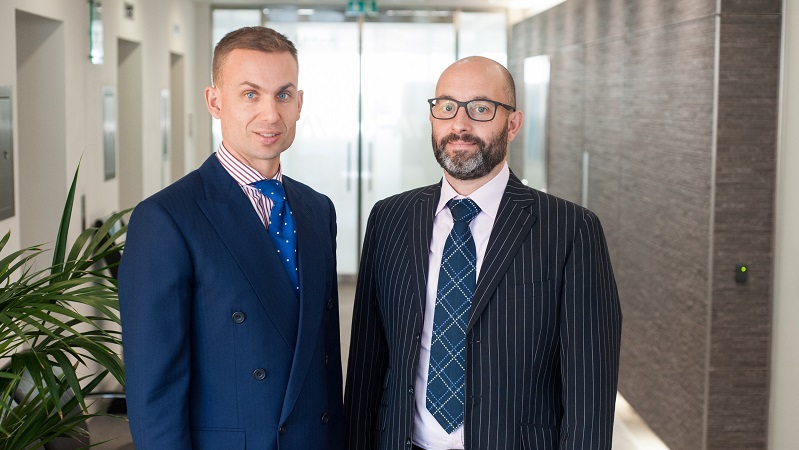Mulling his and co-manager Carlos Moreno’s approach to the £365m portfolio, Thomas Brown (pictured left) says, “We’re in the futurology game”. “We have a relatively long holding period because we wait for the companies to do the outperforming rather than take a trading approach.”
Brown explains the way the stockpicking duo approaches adding value is by predicting what the world might look like in five years’ time. The pair then homes in on companies with a high return on capital, barriers to competition and a decent balance sheet: those best placed to be still thriving in five years and beyond.
But, according to Moreno (pictured right), it is difficult to stand out in a marketplace that is saturated with quant investing approaches, which, he argues, place too much emphasis on the short term. He says the influx of computer-programmed trading and quant strategies is changing the entire investment landscape.
“Our competitors now are all machines. When I started out it was still a human business but now it’s all algorithms and computers,” he says. “There’s no point trying to beat a computer by looking at patterns in share prices or anything in a database, ie short-term earnings. A computer does that cheaper, quicker and better.
“As human fund managers, we’re a dying breed. We’re trying to do something you can’t code for and I’m very suspicious of fund managers whose strategies sound like something I can write a computer programme for.
“It’s difficult to write a computer programme that can predict what the world’s going to be like in five years’ time.”
Impressive figures
It is three years since the inception of Miton European Opportunities and it has posted some impressive numbers in that time. According to FE Analytics, it has returned 3.27% and 72.54% over one and three years, respectively, versus the IA Europe ex UK sector’s -5.21% and 33.28%. The fund is top-quartile over these periods.
It is a multi-cap strategy but the approach tends to throw up ideas in the mid-cap sector, ranging between €2bn and €20bn. While Brown and Moreno are not dogmatic, the portfolio does not tend to contain ideas below €500m because of the liquidity issues stocks of this size and below present.
The pair are comfortable with this mid-cap bias because they say at one end of the spectrum very large companies suffer from the “elephants can’t run” issue; while at the other, very small companies are often binary and therefore risky – either an idea is going to work or it’s not.
“The optimum risk/reward, we tend to find a lot of mid-cap companies,” says Brown.
Brown and Moreno are keen to emphasise their approach is not top-down macro. They like the European index and believe there are plenty of ideas to choose from, but too many people get fixated on the European economy which they believe clouds judgement of the underlying companies.
“People always approach this game topdown, so they always start prattling on about Europe,” says Moreno. “When everyone stops whining about the economy and thinks about the companies quoted in Europe, they can all name a load that make good products. They want to own a German car and dress in European luxury goods.”
The portfolio contains about 50 names with a position spread between 1% and 4%. The pair says having a position below 1% doesn’t add anything to the fund and makes it over-diversified and subtracts from their conviction as active managers. At the other end, above 4% and positions start to bring stock-specific risk to the portfolio.
Brown says the portfolio has two buckets – defensive and cyclicals – split 50/50 and it is relatively simple in its structure, keeping the beta at one and not holding cash, nor does it trade derivatives to flex that beta. “In terms of the assets inside, there is nothing to dissuade the most conservative Mrs Miggins from buying our portfolio because of esoteric derivatives,” says Brown. “We just want to drive the returns through picking stocks.”
Average turnover in the portfolio is about one stock a month, which equates to the pair’s five-year holding period (4.6 years to be precise). Moreno argues that their approach is essentially the reverse of how most brokers work.
He explains: “They lead with valuations, there’ll be endless prattle about the value of the company and then there’ll be some comment on short-term earnings. We are the other way round, so we start with the quality of the business. Is it actually fundamentally a good business? Then you get into the longer-term rather than shorter-term earnings and the valuation you can do very quickly. It’s not rocket science.”
Thematic approach
Four themes run throughout the portfolio: demographics, brand power, technical excellence and online.
Demographics, or the ageing population, is a theme the duo is particularly keen to highlight. Moreno explains the rationale: “The world generates more old people every year because people are living longer. They tend to have all the money because interest rates have gone down and if you’ve owned assets they have gone up in value. They have the votes, so economies are tilted towards old people’s needs.”
The duo is playing this largely through investing in med-tech companies, which is the biggest sector weight in the portfolio. In broad terms, the proportion of a population using prescribed medicines and medical devices such as hearing aids increases with age, and med-tech companies have a vital role to play in catering for this demand. The appeal for Miton is that these companies have predictable and dampened competition because they are semi-regulated businesses.
“They are high-return-on-capital businesses as a consequence of having high barriers to entry, the regulation aspect, the fact they do a lot of R&D and because they generate so much intellectual property,” says Brown.
Med-tech is different to big pharma, however, which Moreno and Brown say they find difficult to analyse and therefore don’t hold in the portfolio.
“It’s hard to look at a drug that’s on phase 2B and predict whether it is going to become commercial,” says Moreno. “We think drug pricing is more of a headwind, whereas medtech is about lowering the cost to deliver healthcare, so there is more of a tailwind.”
Another theme the pair is playing is the so-called ‘internet of things’, and four of the portfolio’s top 10 holdings are what they term “internet-connected businesses”. They highlight top holding Scout24, 3.9% of the portfolio, which is a German property and used car website in the same ilk as Rightmove and Autotrader in the UK, and eighth-largest holding Interoll, a Swiss manufacturer of rollers used in the automation of warehouses.
Online banking and finance is also an area the duo likes, evident in that its 10th-largest position is in Fineco Bank – Italy’s version of Hargreaves Lansdown – and Norwegian internet bank Sbanken. Brown says the banking sector is a winners versus losers situation, making it ripe for disruption.
“The real problem is that banks can’t grow their top line. They’re in gentle decline because the start-ups are all over them and each individual bit is being picked off.”
The duo also sees Europe as very strong on brands, particularly luxury goods and cars. The portfolio’s fifth-largest holding is Ferrari which, interestingly, the pair put into the luxury goods bracket rather than automobiles. With ticket prices starting at £250,000 and going up to £2.5m, Brown classes it as “super luxury”.
“Ferrari’s a lovely story because it produces 8,500 cars a year. Our view is that it could probably get to 20,000 vehicles in the medium term.” The company is also looking to expand the range by producing four door SUVs that Brown argues would make its growth margin very high.
“They’ve got loads of spare capacity at their two plants,” he says. “I think Ferrari’s got a chance of becoming the largest car company in the world.”
The final theme is technical excellence, which is described by Moreno as engineering prowess. Companies that fit this mould include GTT, a French designer of linings for liquefied natural gas (LNG) storage tanks used in shipyards. The shipyards actually build the tanks but GTT owns the intellectual property which it licenses out.
“What’s really cool about it is they have a 99% market share and LNG is actually a growth business because the US is throwing off gas and China needs to shut down all its coal power stations,” says Moreno.
Positive culture
Brown and Moreno have worked together for 10 years having previously been co-managers on the Thames River European Dynamic Growth Fund. They say the partnership has thrived given the culture at Miton and the confidence senior management has in them, particularly its penchant for non-benchmarked funds.
“Fund managers don’t work in isolation, you work within a company that has to want you to do well,” says Moreno. “The success of any great fund manager is a result of a mixture of their skill and the company finding its niche and wanting to nurture them.
“You can be a great football player but if you play for Huddersfield, you’re not going to have many goals. You’ve got to be in the right environment.”







